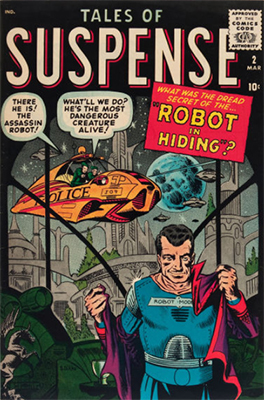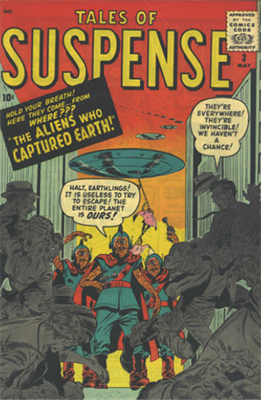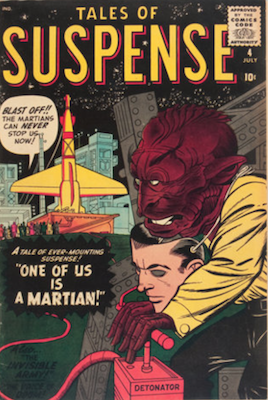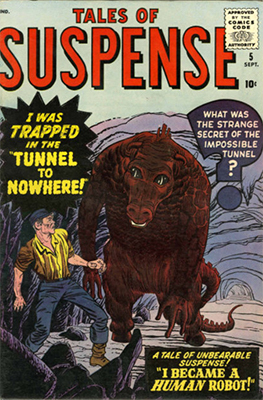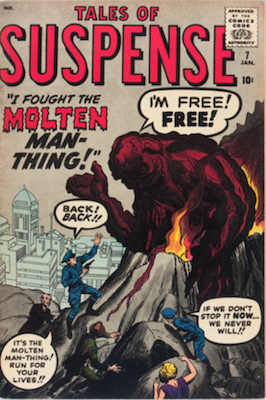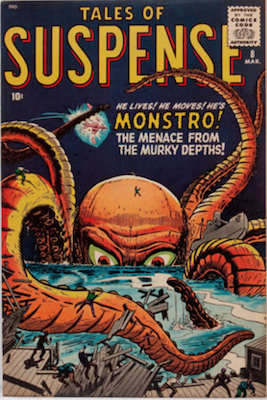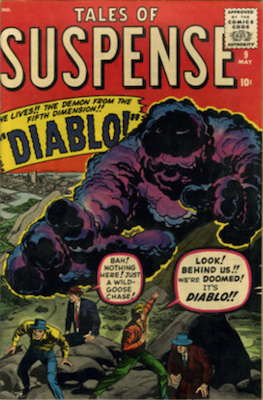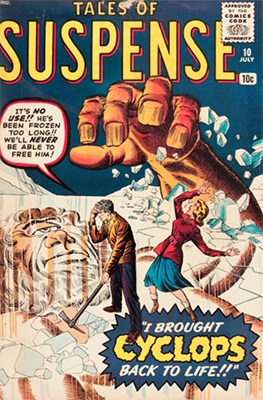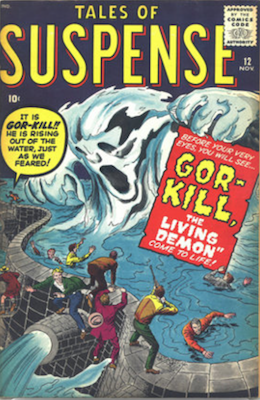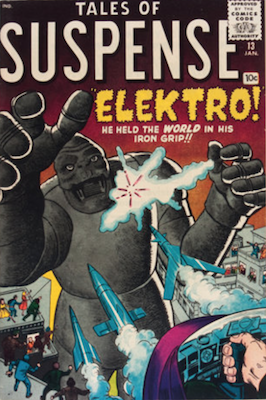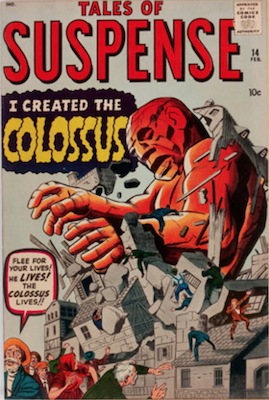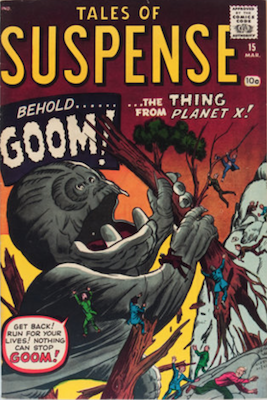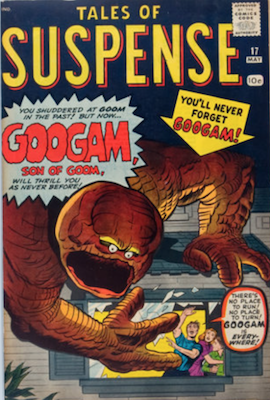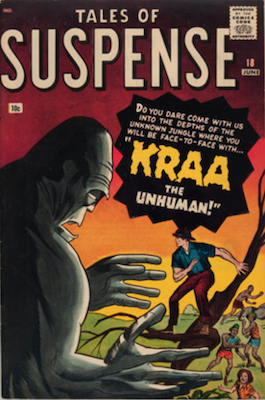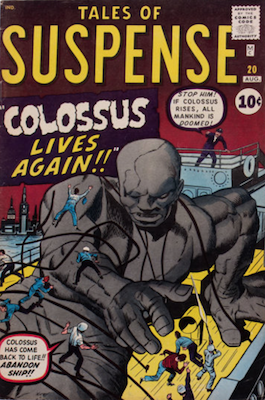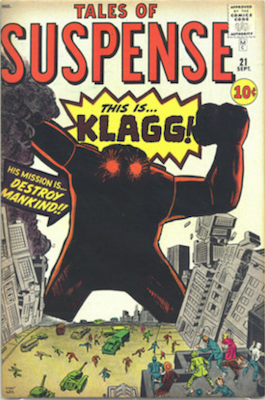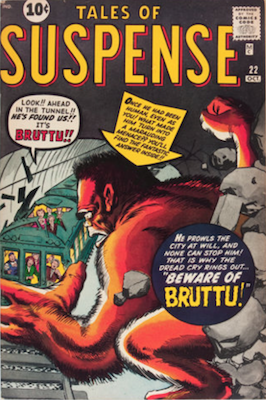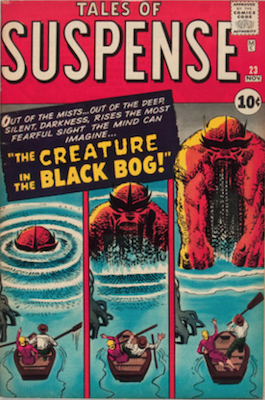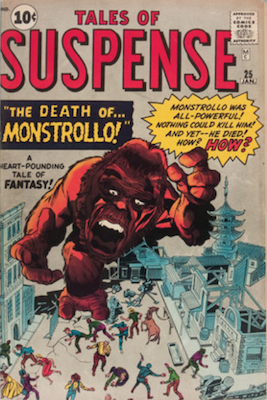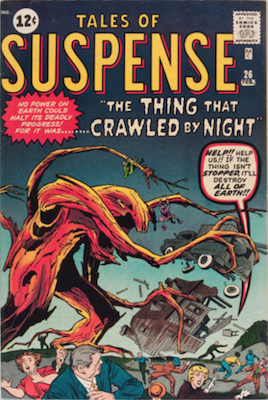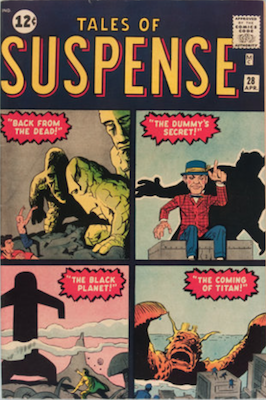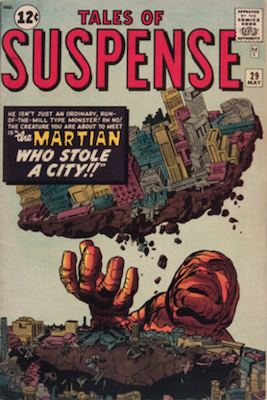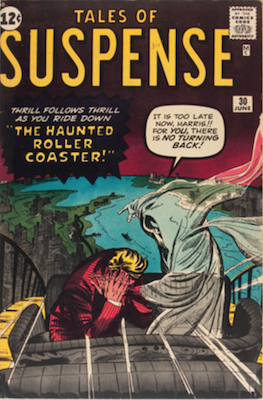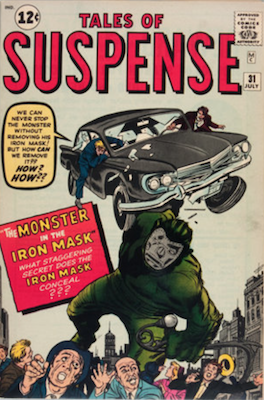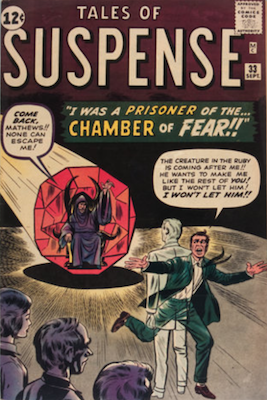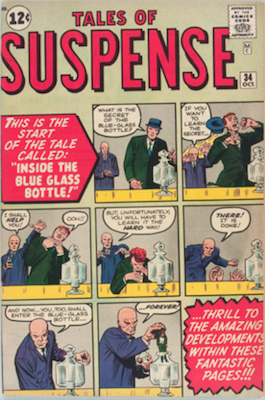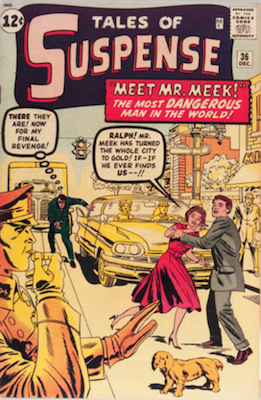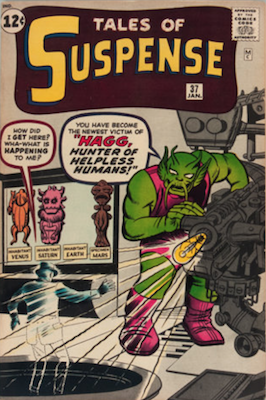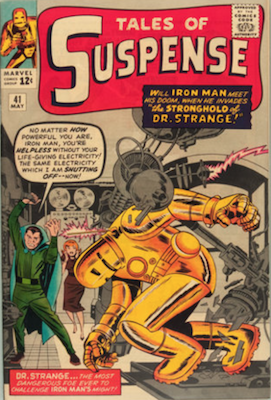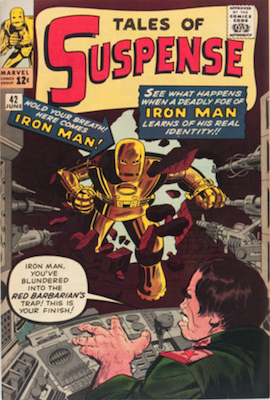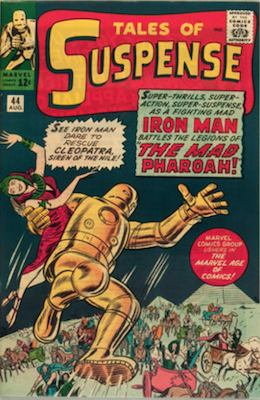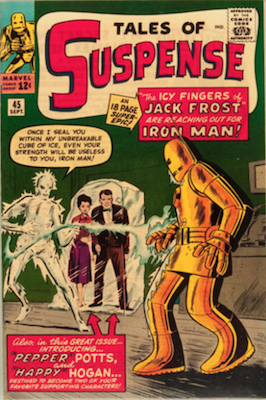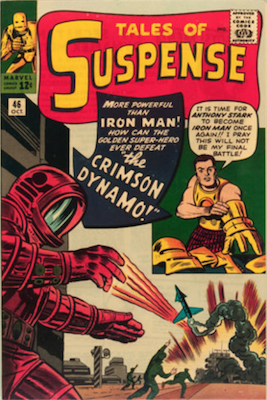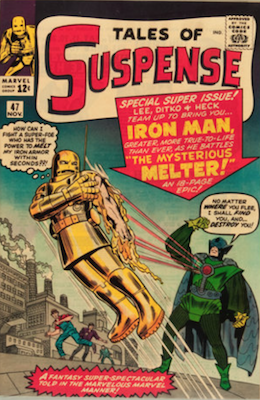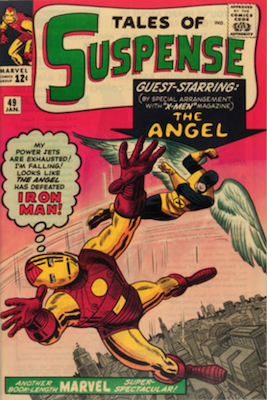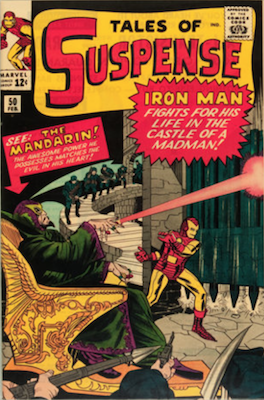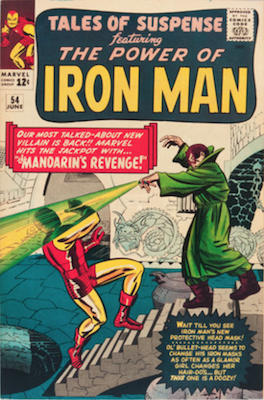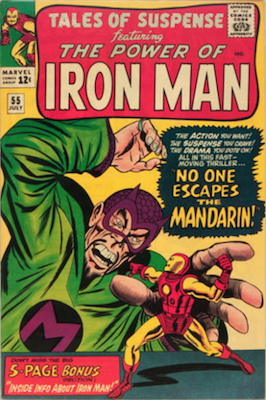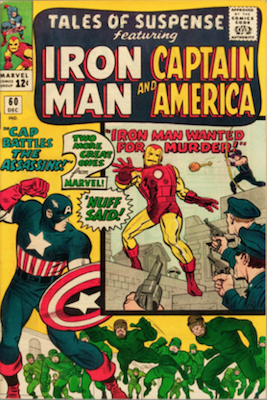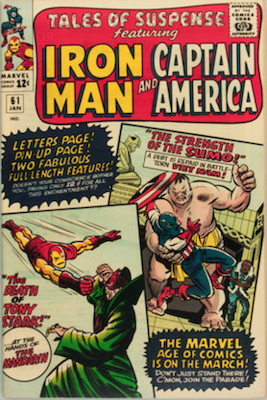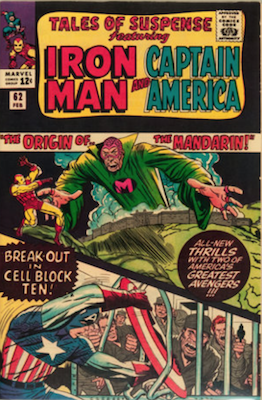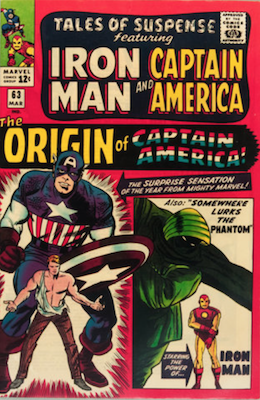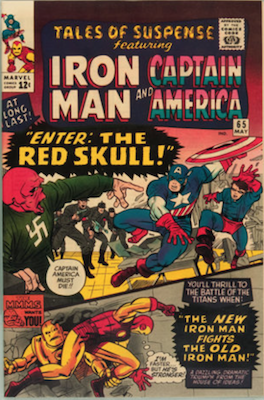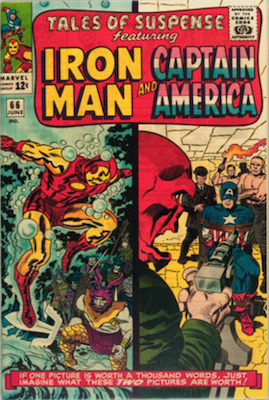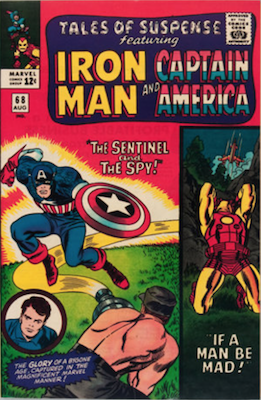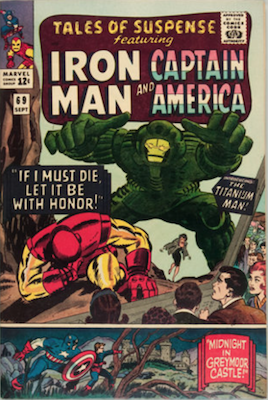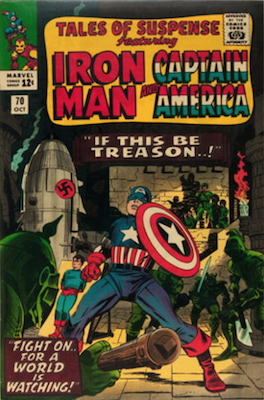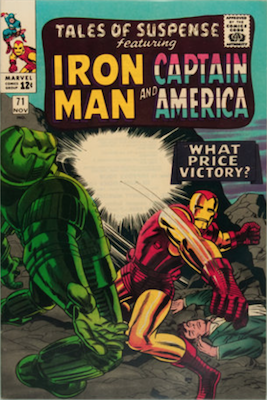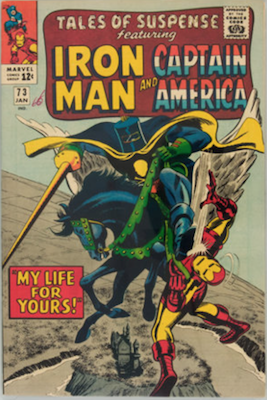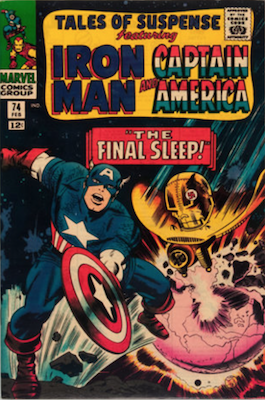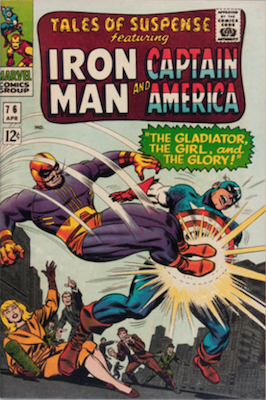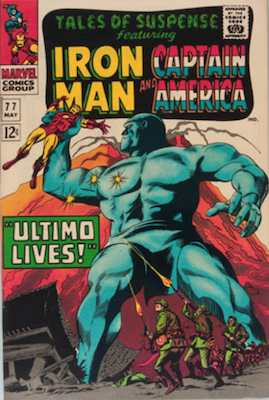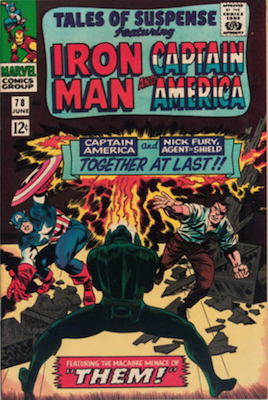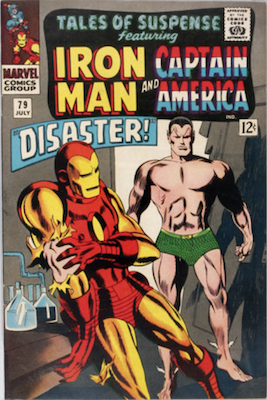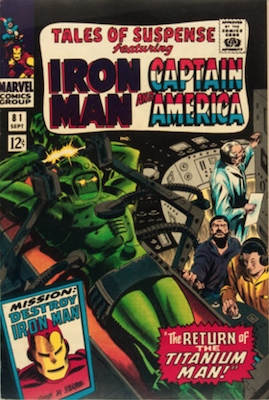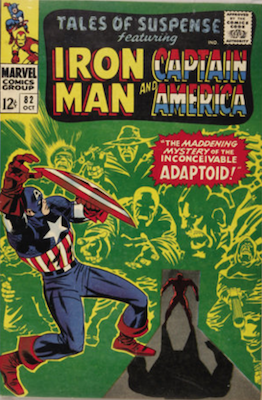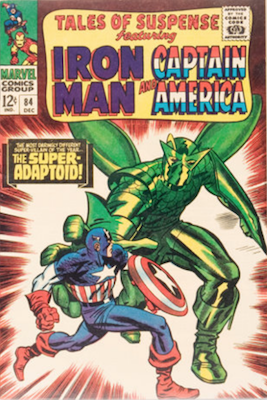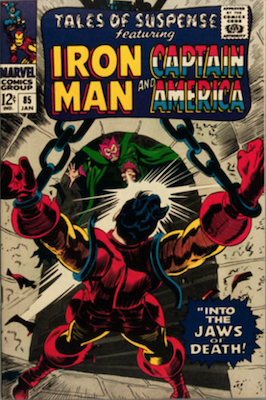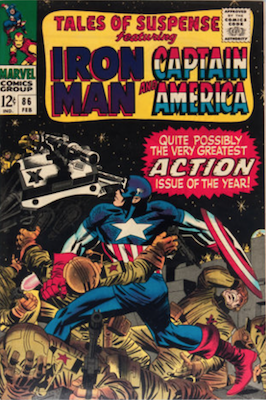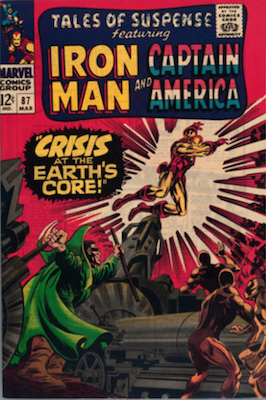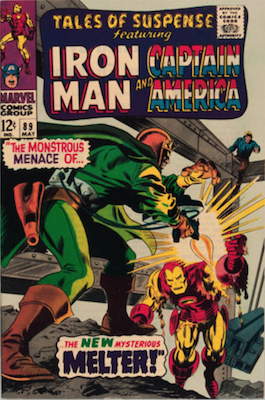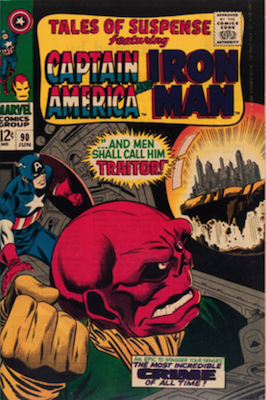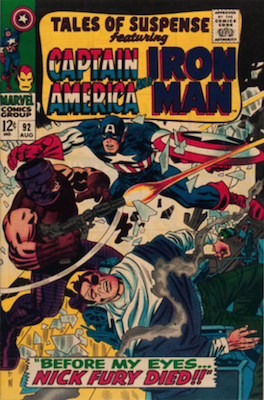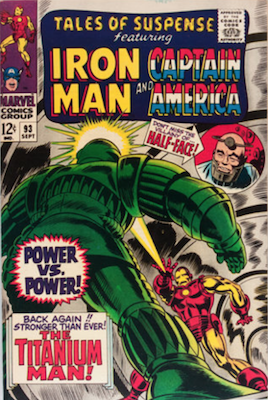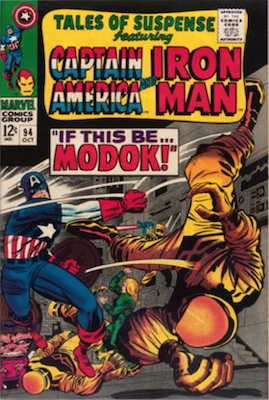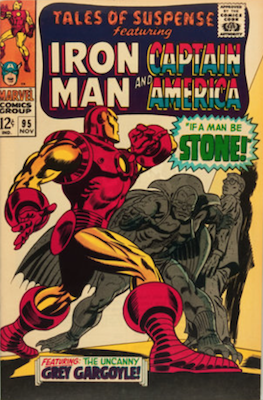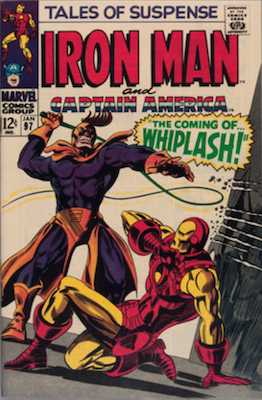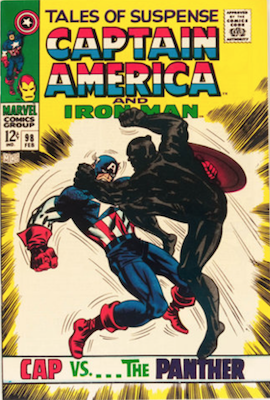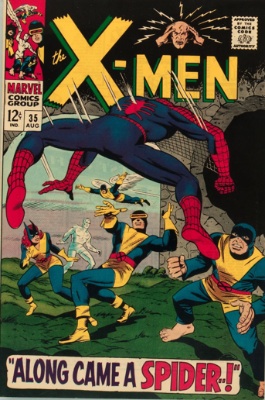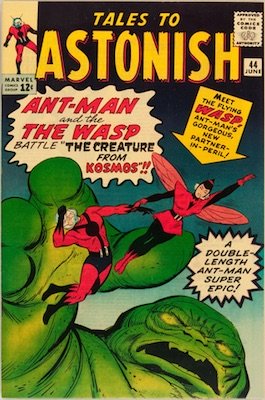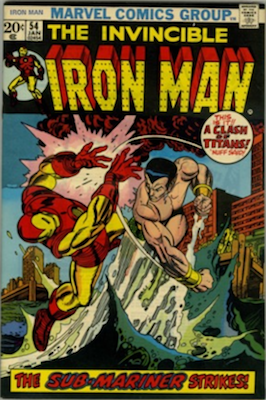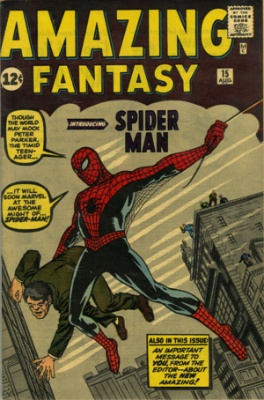Value of Tales of Suspense Comics #1-99
Tales of Suspense Comics Price Guide
ToS started out, like many comics of the late-1950s, as a science fiction anthology title published by Atlas Comics.
It went the way of many Silver Age series, switching over to superhero themes, most notably with the birth of Iron Man in TOS #39, Black Widow in TOS #52 and Hawkeye in TOS #57.
What are your Tales of Suspense comic books worth?
We provide record sales and minimum values for all the key issues in this run. Click any image to see current prices.
Value of Tales of Suspense Comics #1-99
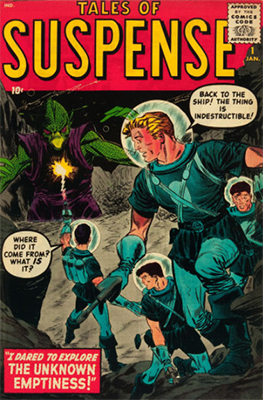
Tales of Suspense #1
Record Sale: $18,000
Minimum Value: $100
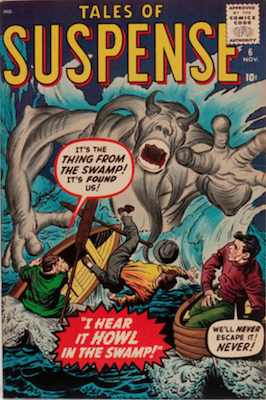
Tales of Suspense #6
Record Sale: $5,800
Minimum Value: $20
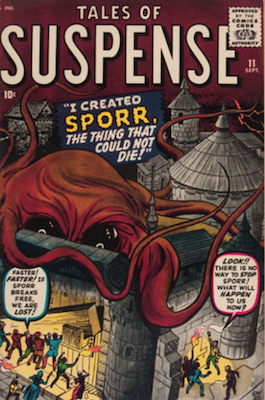
Tales of Suspense #11
Record Sale: $1,400
Minimum Value: $15
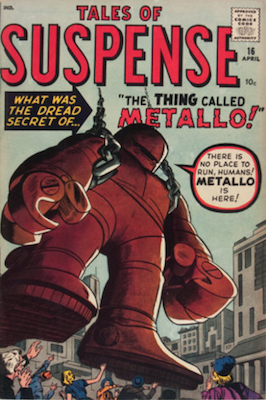
Tales of Suspense #16
Record Sale: $1,300
Minimum Value: $15
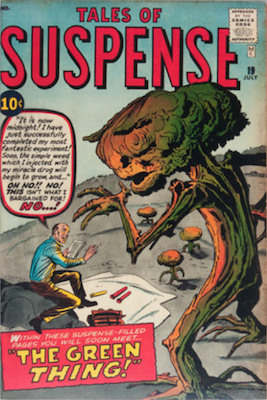
Tales of Suspense #19
Record Sale: $1,100
Minimum Value: $15
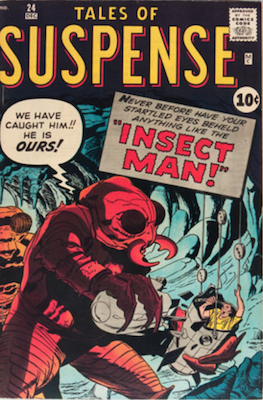
Tales of Suspense #24
Record Sale: $1,000
Minimum Value: $15
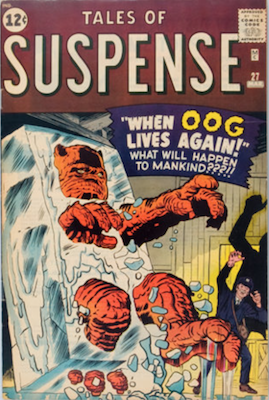
Tales of Suspense #27
Record Sale: $1,250
Minimum Value: $15
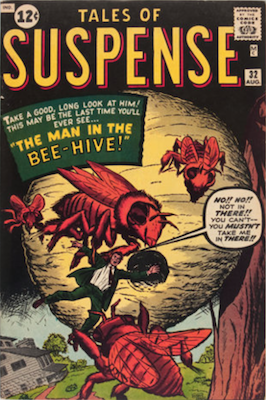
Tales of Suspense #32
Record Sale: $1,600
Minimum Value: $15
(Article continues below)
All Our Horror Comics Price Guides
- 60 Most Valuable Horror Comic Books
- Gallery of the Gross Horror Comics!
- Adventures into Terror
- Adventures into the Unknown
- Astonishing!
- Black Cat and Black Cat Mystery Comics
- Blade the Vampire Slayer
- Chamber of Chills (Harvey)
- Crime Does Not Pay
- Crime SuspenStories
- Crypt of Terror
- Frankenstein Comics
- Ghost Rider
- Haunt of Fear
- House of Mystery
- House of Secrets
- Journey into Mystery
- Marvel Horror Comics
- Marvel Spotlight
- Marvel Tales
- Mister Mystery Comics
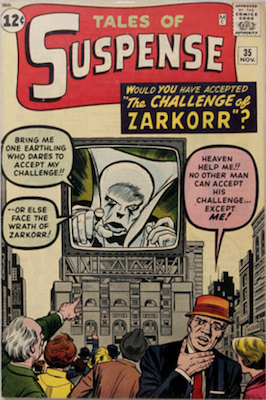
Tales of Suspense #35
Record Sale: $3,100
Minimum Value: $15
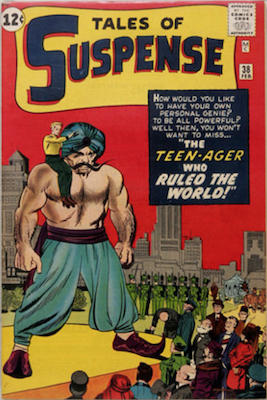
Tales of Suspense #38
Record Sale: $3,300
Minimum Value: $15
KEY ISSUE: Tales of Suspense #39, Origin and First Appearance of Iron Man
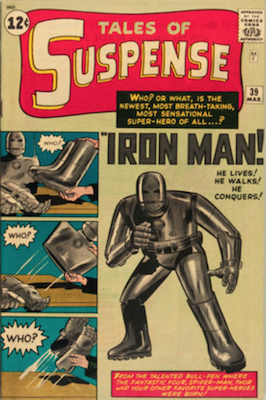
Tales of Suspense #39
Record Sale: $263,000
Minimum Value: $900
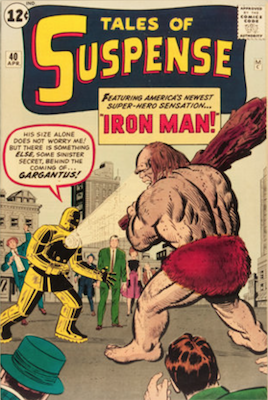
Tales of Suspense #40
Record Sale: $35,000
Minimum Value: $70
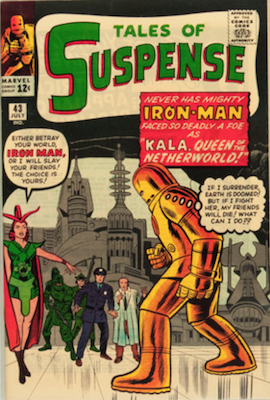
Tales of Suspense #43
Record Sale: $7,800
Minimum Value: $30
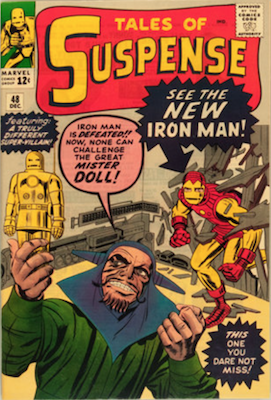
Tales of Suspense #48
Record Sale: $14,500
Minimum Value: $20
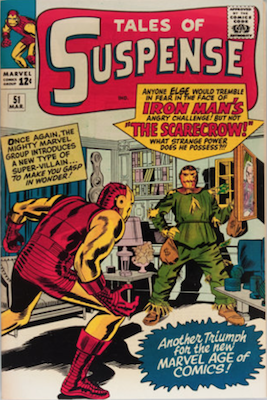
Tales of Suspense #51
Record Sale: $6,500
Minimum Value: $10
KEY ISSUE: Tales of Suspense #52, First Appearance of Black Widow
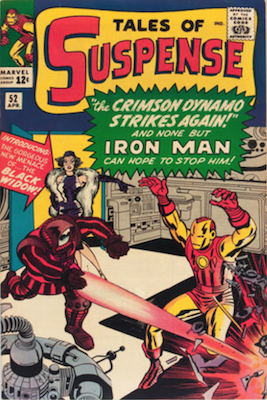
Tales of Suspense #52
First appearance of Black Widow
Record Sale: $60,000 (unverified), $15,000 (verified)
Minimum Value: $150
See also:
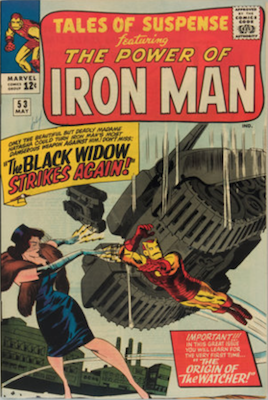
Tales of Suspense #53
Record Sale: $3,300
Minimum Value: $20
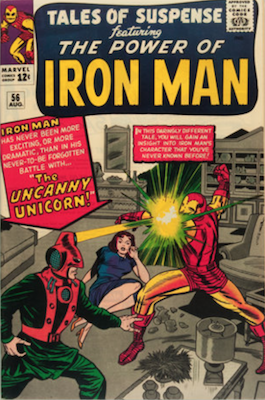
Tales of Suspense #56
Record Sale: $2,000
Minimum Value: $10
KEY ISSUE: Tales of Suspense #57, Origin and First Appearance of Hawkeye
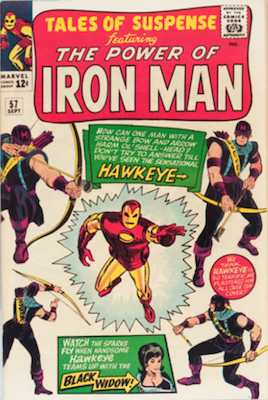
Tales of Suspense #57
Record Sale: $48,000
Minimum Value: $60
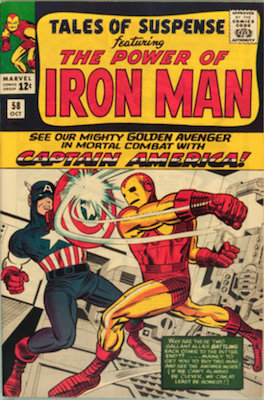
Tales of Suspense #58
Record Sale: $13,000
Minimum Value: $40
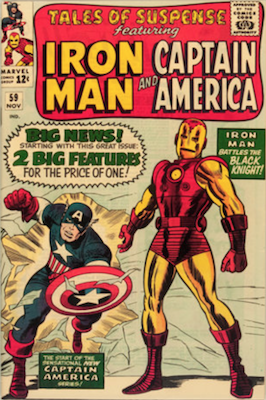
Tales of Suspense #59
Record Sale: $7,000
Minimum Value: $20
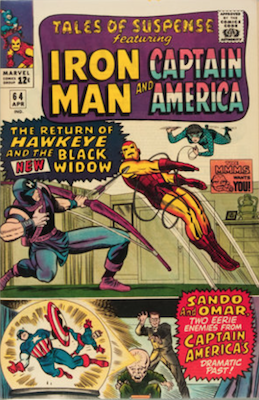
Tales of Suspense #64
Record Sale: $3,150
Minimum Value: $10
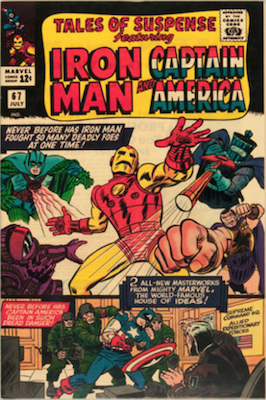
Tales of Suspense #67
Record Sale: $3,700
Minimum Value: $10
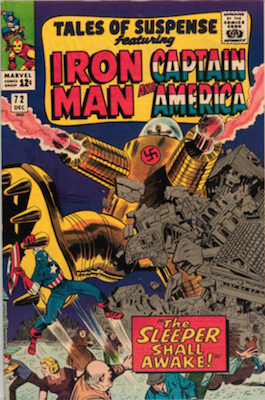
Tales of Suspense #72
Record Sale: $1,500
Minimum Value: $5
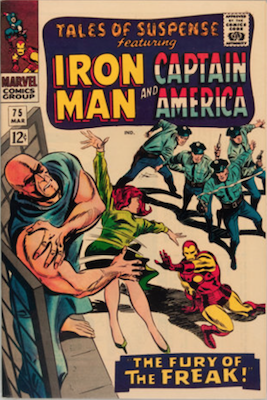
Tales of Suspense #75
Record Sale: $2,000
Minimum Value: $5
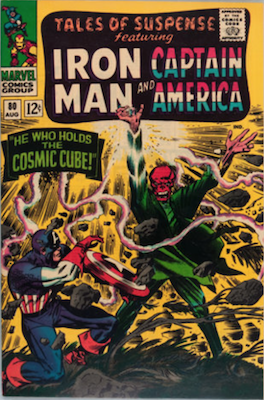
Tales of Suspense #80
Record Sale: $1,700
Minimum Value: $5
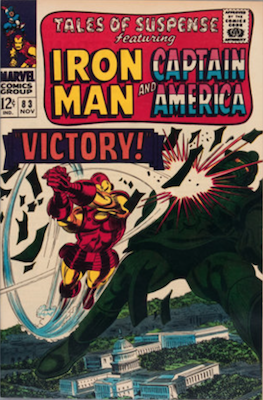
Tales of Suspense #83
Record Sale: $1,200
Minimum Value: $5
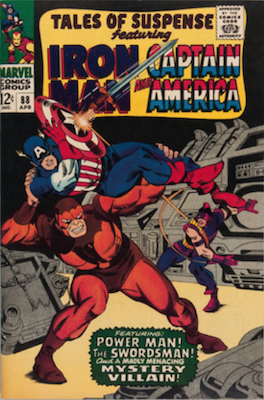
Tales of Suspense #88
Record Sale: $2,700
Minimum Value: $5
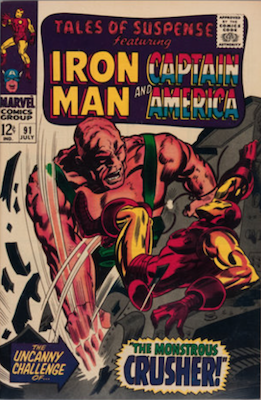
Tales of Suspense #91
Record Sale: $700
Minimum Value: $5
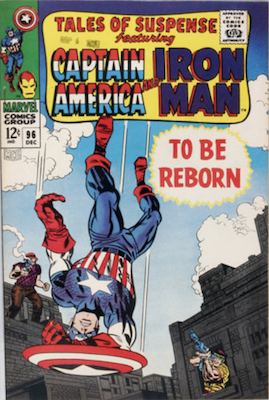
Tales of Suspense #96
Record Sale: $830
Minimum Value: $5
Final Issue: Tales of Suspense #99
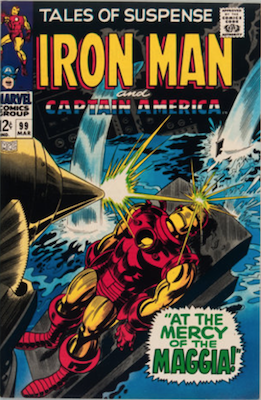
Tales of Suspense #99
Record Sale: $900
Minimum Value: $5
History of Tales of Suspense Comic Books
This issue appeared with little fanfare as 1959 dawned. Just three years into the Silver Age, and Atlas still hadn't started with superheroes yet, nor had they made the transition to Marvel.
Functionally, there is little difference, but the people who care about such things seem to like to argue about it. In essence, all the Marvel ingredients were in place once Jack Kirby's work began appearing regularly in Atlas Comics titles in issues dated April, 1959.
Some collectors therefore refer to any Atlas title after that date as "pre-hero Marvel," even though the name Marvel Comics wouldn’t appear until Journey Into Mystery #69 in June of 1961. Most seem to agree, at least, that ToS #1 is definitively an Atlas Comics title. Phew.
Now that that's settled, we can get down to business. Tales of Suspense #1 features six stories, pretty much in the science fiction genre, including tales of alien invasions, space travel, extraordinary abilities, time travel, and bizarre coincidence, often with the ironic twist endings that were very popular in 1950s comics of this type.
The writing is almost all by Stan Lee and/or Larry Lieber, and the pencils are by Don Heck, Al Williamson, Steve Ditko, and John Buscema. In other words, it's great stuff if you like classic Marvel Comics.
The cover is ostensibly by Don Heck, but yours truly is willing to go out on a limb and suggest that either John Buscema penciled the cover or else he inked Heck's pencils very heavily, as the work looks much more like Buscema's.
Whether it’s as interesting or "essential" as the later superhero issues of Tales of Suspense, ToS #1 is very valuable to collectors. The non-superhero issues that followed are all quite as good as #1, but of course are in general less valuable.
Now, we're talkin'! ToS #39 marks the first appearance of the character who, while always popular, never seemed likely to burst into the popularity that the three Iron Man movies have given him. Ol' Shellhead debuts here, and while his origin is well-known by now, it behooves us to think about how things have been retconned and changed in the years since.
Of course we know about millionaire industrialist Tony Stark, and yada yada yada. Long story short, Tony is in Vietnam demonstrating a new gadget for the military (special, super-powered, "transistorized magnets") when he is wounded by a landmine and then captured by the Communist warlord/tyrant Wong Chu. Yes, Iron Man is a product of the Cold War and the burgeoning Vietnam Conflict.
Tony is forced to invent new weapons for Wong Chu, in exchange for a promised life-saving surgery that will supposedly save him "before the shrapnel reaches his heart." I know. Don't ask questions. It's easier that way. Anyhow, Tony instead builds himself a cockamamie iron suit with a chest plate that uses the "transistorized magnets" to keep the shrapnel at bay.
Of course, the iron get-up is also equipped with weapons, and protects Tony from bullets and most other harm while he's inside. He defeats and seemingly kills Wong Chu, and slinks off into the jungles of Vietnam, with an overcoat and fedora covering his huge and cumbersome iron suit.
The suit is gray and bulky in this first iteration, and looks like something a deep-sea diver would have worn, although no doubt it seemed very high-tech at the time to Stan Lee and Don Heck, who wrote and penciled this issue. Jack Kirby and Don Heck did the cover together.
If you've been alive and had any sort of connection to pop culture over the last five years, you know about Iron Man. The suit would soon change, and Tony's life will become interesting and tragic, and we'll eventually be made to feel sympathy for a millionaire industrialist who capitalizes on the making of war.
If that weren't enough, expect this comic, should you turn one up, to fetch several thousand dollars in average shape. Iron Man's recent move into the upper echelon of superheroes (right now he's more profitable than Spider-Man) has driven values up, up, up.
Read more about this first appearance of Iron Man here.
In ToS #40, Tony Stark, playboy millionaire that he is, succumbs to the whim of one of his girlfriends, Marion, who tells him that Iron Man would be more glamorous if his armor was golden instead of that dreary old grey. I'm not joking. That's why the gold armor.
At this point, we realize that Tony has already set up the ruse that Iron Man is his bodyguard. Marion doesn't know that Tony is really Shellhead, but when a beautiful girl talks, Tony Stark listens, and so Iron Man transitions to armor #2.
The story is not as important in ToS #40. Iron Man must battle Gargantus, a "giant Neanderthal" who has captured the town of Granville and is holding them all hostage with his oversized caveman club. Again, not joking.
Since Tony was supposed to pick Marion up from a flight at the Granville airport, he investigates as Iron Man, and defeats the troglodyte, who turns out to be an alien creation, a "super Neanderthal robot." See, the aliens had last visited earth so long before that the only earthlings they'd encountered were Neanderthals.
So, Iron Man wins, and sends them packing. Along the way we see for the first time Iron Man's jet-powered skates (he doesn't fly yet) and his briefcase, which is about as unlikely a place to store that huge, bulky suit of armor as Barry Allen's ring is to store his Flash costume.
ToS #40 is as valuable as #39, and is every inch classic Marvel, with a Stan Lee script and art by Jack Kirby and a cover by Don Heck.
In ToS #46, we meet Iron Man's Soviet counterpart, the Crimson Dynamo, for the first time. Before ol' Shellhead went for the red and gold color scheme, he fought a genuinely "Red" villain.
In a lab deep inside the USSR, Professor Anton Vanko is visited by none other than Nikita Kruschev. After witnessing the awesome power of the Crimson Dynamo armor that Vanko has developed, Kruschev orders Vanko to the USA to eliminate Iron Man and sabotage Stark Industries' latest efforts in defense.
Well, Vanko travels to the states, makes numerous attempts to sabotage Stark's latest gadgets, and is ultimately tricked by Iron Man into confessing to all his crimes of sabotage. The ruse is so successful that Vanko defects, and agrees to work for Tony Stark thereafter.
Kruschev, perhaps unsurprisingly, is goaded into a shoe-slamming-on-table fit of rage, and vows to destroy Iron Man. Scripted by Stan (The Man) Lee, and penciled by (Dashing) Don Heck, with a Jack Kirby cover, ToS #46 is worth far less than earlier issues.
After battling a villain named Mister Doll, who has a voodoo-like power to cause pain with a small, clay doll, Iron Man plunges into the ocean, and nearly drowns.
He crawls from the water just in time, and after recharging his armor back at Stark Industries, he vows to create a new suit of armor that will be lighter, and put less strain on his damaged heart.
Tony's efforts result in what Iron Man scholars call the "Mk III" armor ("Mk I" being the bulky grey armor and "Mk II" the gold redux), a lighter, sleeker, red and gold affair that accents the musculature that we never knew Tony had.
Even millionaire industrialists have well-defined pectoral and abdominal muscles, it seems.
The new armor is jazzy and slick, giving Iron Man the power of unrestricted flight, and he defeats Mister Doll handily.
Steve Ditko designed the Mk III armor, and did the pencils for this issue, with Ditko's fluid style offering a welcome change from Don Heck's more static work. Stan Lee wrote the script, and Jack Kirby did the cover. A very worthwhile issue of Tales of Suspense issue to find laying around!
The first Silver Age solo appearance of Captain America is big news, no matter how you slice it. Sure, it'd been Iron Man's book for 20 issues, and sure, ol' Shellhead was pretty groovy. But this is Captain America we're talking about, and that has a big impact on values.
Tony Stark's got nothing on Steve Rogers, it would seem. Marvel decided that Cap was worth bringing back, finally doing what DC'd been doing with its Golden Age heroes, but instead of a reboot, Cap was the real deal, having been in suspended animation in an iceberg for almost 20 years.
Stan Lee and Jack Kirby bring back Cap for his first solo outing after appearing, defrosted, in a few issues of The Avengers. The story has Cap all alone at Avengers mansion having to deal with a bunch of thugs who think he'll be easy pickings because of his lack of "real" super-powers (the Super Soldier Formula hadn't really been dealt with yet, and Cap didn't yet have the super strength he'd get later). Of course, Cap wipes the floor with the thugs.
The Iron Man story in this issue has Shellhead battling the Black Knight. No, not Dane Whitman, the hero Black Knight who would later be a member of the Avengers until being turned to stone by the Enchantress. This was Whitman's uncle, Nathan Garrett, a smuggler and dyed-in-the-wool villain.
Stan Lee and Don Heck handle the script and art chores for this story. Jack Kirby, as usual, penciled the cover, which is iconic and a classic example of the "Mighty Marvel" style.
You can read more about Silver Age Captain America comic values here.
Tales of Suspense #65 features the reappearance of the Red Skull, Cap's old WWII-era menace.
Well, er, sort of. The Red Skull we see in this issue's Captain America story (a wartime flashback featuring Cap's sidekick, Bucky Barnes, who'd died at the hands of Baron Zemo in the closing days of the war) is not, strictly speaking, the "actual" Red Skull.
This one is an industrialist named Maxon rather than Johann Shmidt, the better-known Skull. Cap and Bucky unmask him, and foil his plans, of course. The "real" Skull would appear in the next issue. The story and art are classic Lee and Kirby, and you wouldn't want it any other way.
The Iron Man story in this issue, by Lee and Heck, involves Shellhead battling a small-time thief named Weasel Willis, who has stolen the Mk II, golden armor, which had been misplaced after being retired. "The New Iron Man Fights the Old Iron Man!" proclaimed the cover, which was, as usual, done with flair by Jack Kirby.
Quite a valuable issue because of the Red Skull's reappearance, even though it isn't the "real" Red Skull.
Finally, the "real" Red Skull shows up! Continuing from last issue, Stan Lee and Jack Kirby bring us the story of Cap and Bucky (back in WWII), captured sneaking behind enemy lines in Nazi Germany, and brought before the true Red Skull, Johann Shmidt, who tells them his origin.
An orphan filled with hate working as a bellhop in a hotel, he was hand-picked by Hitler himself, after the Fuhrer recognized something in the boy he thought he could use. After telling Cap his origin story, the Skull brainwashes him into seeking out and killing the commander of all the Allied Forces.
This issue's Iron Man story is as usual brought to you by Stan Lee and Don Heck, and features the Golden Avenger battling Namor's nemesis Attuma, taking advantage of his groovy new armor's ability to allow him to breathe underwater.
This Mk IV armor is the version that would last until the mid-'70s, and would occasionally feature a nose. The fantastic Kirby cover is typical of this period, split between action panels from both the Iron Man and Captain America stories.
Tales of Suspense would end with #99. The comic's numbering would continue as Captain America with #100, while Iron Man would get his own comic starting with #1 after a one-shot issue shared with the Sub-Mariner.
This issue features a wonderful Gene Colan cover, illustrating exactly why he was one of Marvel's best (although not as revered as Kirby or Ditko, for example) artists. Colan's work on Iron Man, along with his work on Daredevil and the early Captain Marvel (Mar-Vell, that is) stands as some of Marvel's finest.
The Iron Man story in this issue has Shellhead at the mercy of that incredibly well-known Italian-American organized crime group known as the Maggia. Yes, of course, the Maggia.
Of all the things that the Comics Code did to the medium, perhaps the silliest was banning words like "Mafia" and "zombie," leading to such ridiculous and inexplicable coinages as "Maggia" and "zuvembie." I kid you not.
Anyway, the Maggia hires Whiplash to do Iron Man in. Needless to say, Tony Stark lives to fight another day. The story features a typically great Stan Lee script along with the exemplary Colan pencils.
The Captain America story in ToS #99 is another typically excellent Stan Lee/Jack Kirby Cap adventure, this one involving Baron Zemo and a guest appearance by T'Challa, the Black Panther.
The cover doesn't illustrate the Cap story, since Gene Colan didn't generally go in for split covers like Kirby had. Instead, the cover uses the full area to help generate tension.
This was the end of Tales of Suspense. As the '60s (and the Silver Age) waned, Marvel began cancelling off most of their anthology titles.
ToS was one of the last holdouts, and should be remembered as a major comic in Marvel's history, as well as one of the most consistently well-done comics, with the later-'60s issues, dominated by Stan Lee's writing and the pencils of Colan and Kirby, typifying what made Marvel so great in their heyday.
More of our Comic Price Guides
Other Marvel Comic Superheroes in Tales of Suspense Comics
See the values for Amazing Spider-Man, X-Men, Avengers, Thor and more.
Tales to Astonish Comic Book Values
The classic run which gave rise to Ant-Man, Wasp and Giant-Man, and the return of Hulk in the Silver Age.
Invincible Iron Man Comic Book Price Guide
Tony Stark's armor-clad creation is a hot collectible. Find out which comic books are the best!
The Most Valuable Comic Books of the Silver Age
Tales of Suspense #39 appears on the most expensive comic books of the Silver Age list. Find out where!

